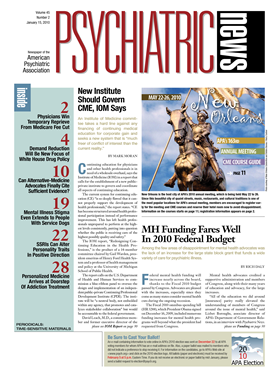Much has been learned about sexual orientation and gender identity in the 37 years since homosexuality was determined not to be a mental illness and removed from DSM-II.
Yet child psychiatry residents may need to learn more about the mental health needs of sexual minorities, according to two PGY-6s who spoke at the American Academy of Child and Adolescent Psychiatry's annual meeting in Honolulu last November.
“The majority of gay and lesbian adults demonstrate healthy, adaptive functioning, and homosexuality is not universally associated with psychopathology as it once was [believed to be],” said Scott Leibowitz, M.D., of Children's Hospital Boston.
Nonetheless, epidemiology data suggest that there are higher rates of some psychopathology among lesbian and gay youth than among their heterosexual peers, said Leibowitz.
Those problems may have as much to do with societal pressures and stigma as they do with individual psychology, so psychiatrists must understand the world in which these young people live, he said.
He cited several studies documenting levels of depression, anxiety disorders, and high-risk sexual behaviors among gay, lesbian, and bisexual youth. Suicidal ideation and attempts may be as much as three times higher, especially among young people who have had same-sex experiences but have not labeled themselves as gay or lesbian.
Other risk factors include isolation, victimization or bullying, rejection by family or friends, and consequent alienation from familiar support systems.
In addition, homosexual youth may internalize homophobia and have to deal with the conflict between the simultaneous development of a gay sexual identity and the need to feel socially accepted.
Furthermore, “Be aware of the increased rates of psychopathology, unique needs, and specific risk factors faced by sexual minority youth,” Leibowitz advised clinicians.
Even medical students or residents familiar with homosexuality may not be exposed to another sexual minority. Seeing patients with gender identity disorder—the “persistent sense of discomfort about one's anatomical sex and a strong desire to change [it]”—is not a mandatory part of training, said Leibowitz. “Clinicians don't have a standard, evidence-based approach to dealing with the broader goals of treatment,” which involve hormones and surgery, he said.
Psychiatry training should include an expanded curriculum development that exposes residents to patients with gender-variant behavior and sexual-orientation issues, he said.
Some medical schools have offered programs, but results have been mixed, said co-presenter Joel Stoddard, M.D., of the University of California, Davis.
A study of a UC-Davis curriculum produced “underwhelming” results, said Stoddard. “The students said they wanted specific clinical discussions and fewer lectures.”
Students at the University of California, San Francisco requested and received a similar curriculum, but also termed it too brief, said Stoddard. More of these students found variation in sexual orientation among their patients easier to deal with than gender identity issues.
Intensive discussions of case vignettes may clarify many of the diagnostic and treatment questions in this population, he said.
Stoddard recommended a model syllabus on gay, lesbian, bisexual, and trans-gendered mental health prepared by the Group for the Advancement of Psychiatry and available on the Web site of the Association of Gay and Lesbian Psychiatrists.
Finally, suggested Leibowitz, “[a] confidential clinical alliance, while important for all youth, remains even more crucial when dealing with sexual minority youth who may unconsciously expect to face rejection and isolation from their clinician.”
The syllabus is posted on the Association of Gay and Lesbian Psychiatrists' Web site at <www.aglp.org/gap/>. 

